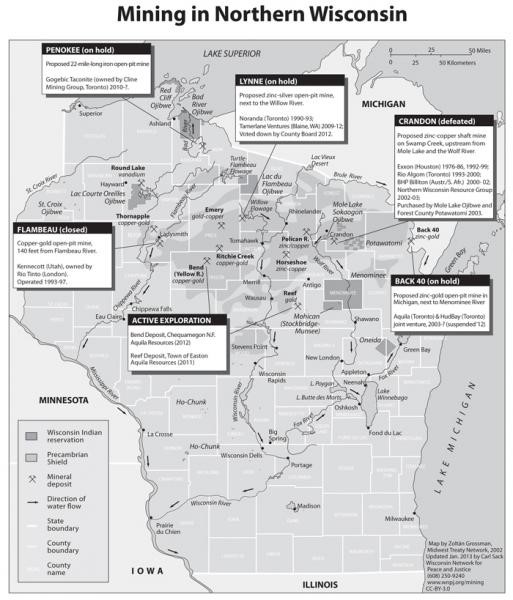In order to protect waters statewide, Wisconsin’s Prove It First Law requires companies to show examples of a metallic sulfide mine that has operated for ten years without causing environmental harm and a mine that has been closed for ten years without causing environmental harm. The Prove It First law protects Wisconsin from unproven and harmful metallic sulfide mining as metallic mining is the largest producer of toxic waste by industrial sector in the US, and these mines often continue to pollute long after being closed.
Open Pit Mining
 One of the most common form of mining, open pit mining involves removing the Earth’s surface to obtain minerals or metals. Typically, many tons of ore must be removed as the minerals sought after are often available in low concentrations, even in rich seams. Not only do open pit mines release metallic dust, asbestos-like minerals, and radioactive elements, but also produce large amounts of liquid wastes called tailings. These tailings must be stored in lagoons or landfills that are frequently the source of soil and water contamination.
One of the most common form of mining, open pit mining involves removing the Earth’s surface to obtain minerals or metals. Typically, many tons of ore must be removed as the minerals sought after are often available in low concentrations, even in rich seams. Not only do open pit mines release metallic dust, asbestos-like minerals, and radioactive elements, but also produce large amounts of liquid wastes called tailings. These tailings must be stored in lagoons or landfills that are frequently the source of soil and water contamination.
The Flambeau Mine
A copper, gold, and silver open pit mine operating a mere 140 feet from the Flambeau River in northern Wisconsin, the Flambeau Mine operated from 1993 to 1997. The Wisconsin DNR and federal Environmental Protection Agency determined that the Flambeau Mine contaminated a tributary of the Flambeau River with zine and copper to the extent that the tributary is considered an impaired water.
Of course, mining hasn’t only negatively impacted the water in Wisconsin:
Beal Mountain Mine
This open pit gold mine in Montana closed its doors in 1998 and has been polluting headwater streams of the Clark Fork River with cyanide and selenium for years.[i] With a parent company who went out of business a year after the mine closed, millions of taxpayer dollars have been spent attempting to reclaim the contaminated site, with estimated cleanup costs ranging from $25 million to $250 million.[ii]
Summitville Gold Mine
This mine started leaking cyanide soon after construction in 1986, and in 1990 it killed almost every living thing in 17 miles of the Alamosa River due to heavy metal and acid pollution.[iii] With another owner going bankrupt, taxpayers have spent over $200 million cleaning up the site. Another $2.5 million must be spent annually to treat the water and manage the site.[iv]
Mount Polley Mine
In 2014, the tailings dam collapsed at this British Columbia mine, leaching billions of gallons of wastewater and almost 6 million cubic yards of sludge into nearby rivers and lakes. A nearby creek supporting a run of endangered Coho salmon turned into a river of sludge over 140 feet wide. Quesnel Lake, a source of drinking water for locals and considered the cleanest deep-water lake in the world, was also polluted by this toxic sludge.[v]
[i] https://www.nrcm.org/projects/waters/open-pit-metal-mining-in-maine/
[ii] http://helenair.com/news/state-and-regional/cleanup-costs-mount-at-beal-mountain-mine-site/article_99b32fbe-351b-5fe6-9651-caeb10c14260.html
[iii] http://www.nytimes.com/2001/01/07/us/the-death-of-a-river-looms-over-choice-for-interior-post.html
[iv] https://www.nrcm.org/projects/waters/open-pit-metal-mining-in-maine/
[v] http://bangordailynews.com/2014/08/20/opinion/contributors/canadian-mine-disaster-offers-maine-a-lesson-strong-regulations-enforcement-are-critical/